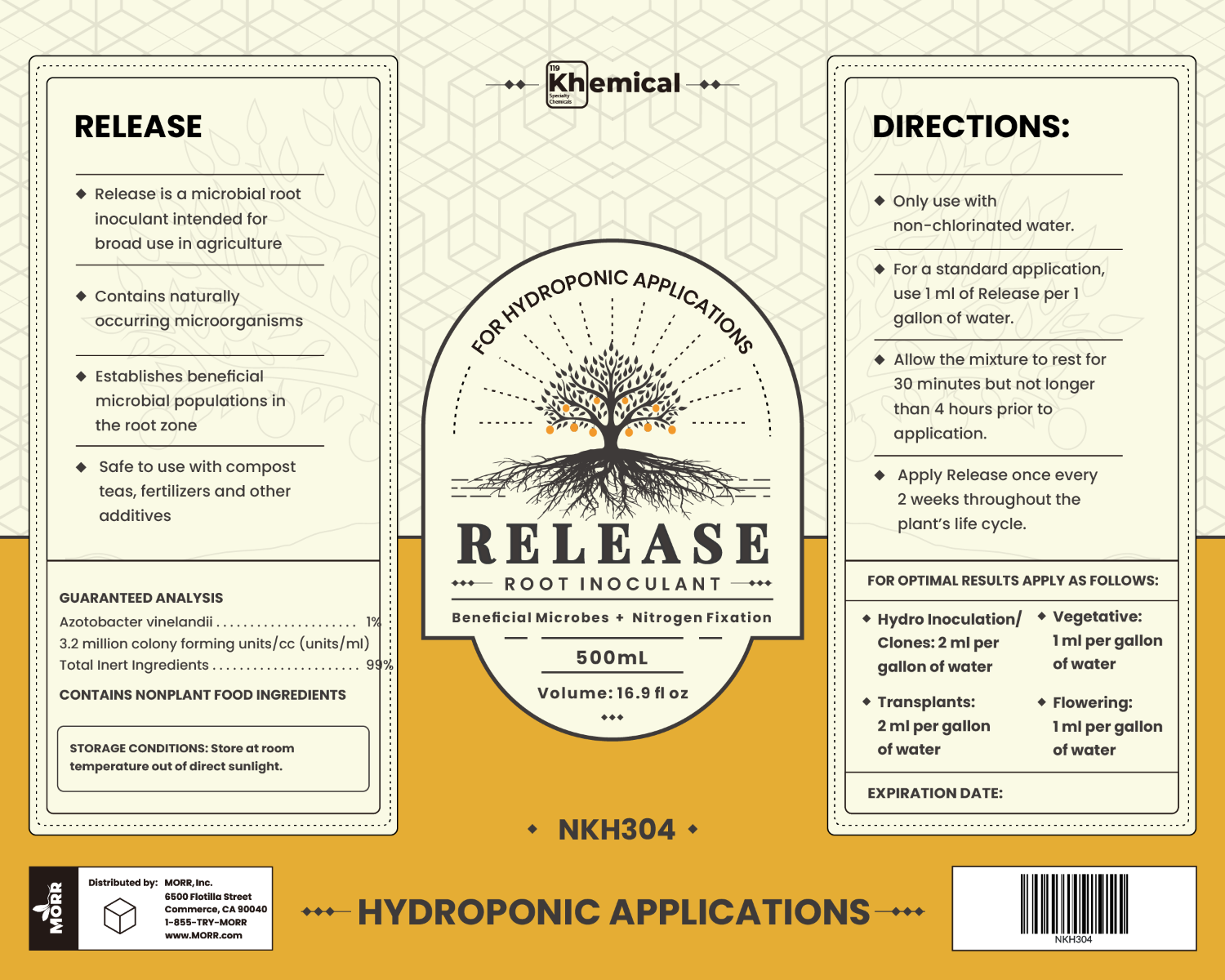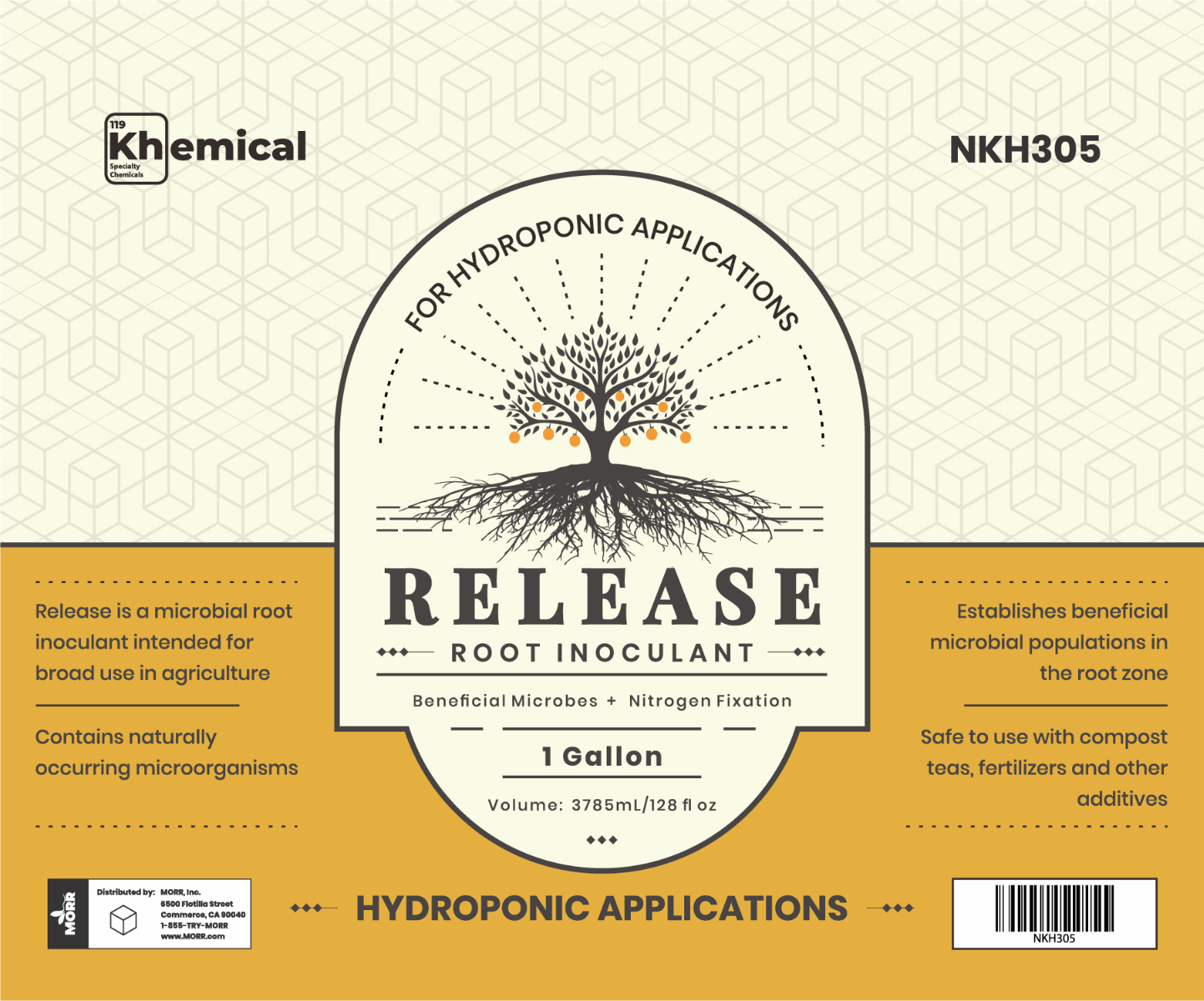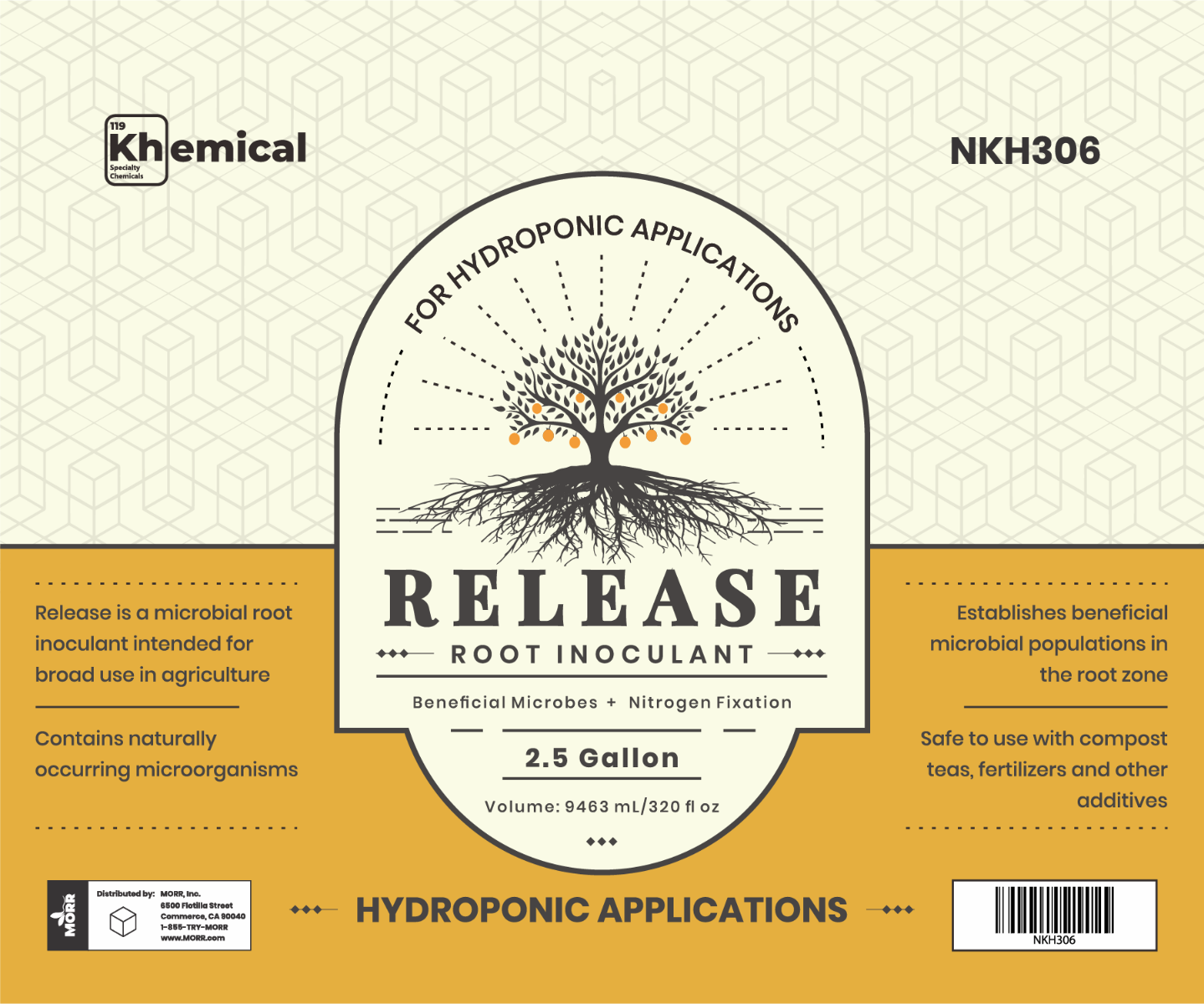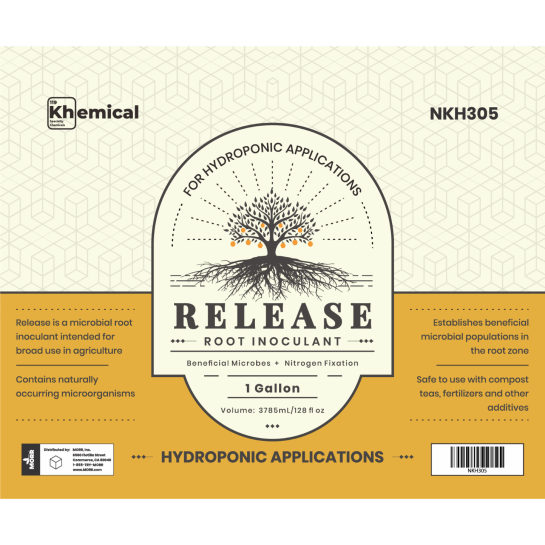Khemical Release Microbial Root Inoculant - Hydroponic Applications

Currently, there are no specifications available for this product.
-
 NKH304 Khemical Release Microbial Root Inoculant - Hydroponic Applications - 500 mL (6/Cs) (1350/Plt)
NKH304 Khemical Release Microbial Root Inoculant - Hydroponic Applications - 500 mL (6/Cs) (1350/Plt) -
 NKH305 Khemical Release Microbial Root Inoculant - Hydroponic Applications - 1 Gallon (4/Cs) (144/Plt)
NKH305 Khemical Release Microbial Root Inoculant - Hydroponic Applications - 1 Gallon (4/Cs) (144/Plt) -
 NKH306 Khemical Release Microbial Root Inoculant - Hydroponic Applications - 2.5 Gallons (2/Cs) (72/Plt)
NKH306 Khemical Release Microbial Root Inoculant - Hydroponic Applications - 2.5 Gallons (2/Cs) (72/Plt)
Details
- What is Release?
Release is a plant root inoculant containing a proprietary blend of beneficial plant growth-promoting rhizobacteria (PGPR, with rhizo = root zone).
- How do I apply Release to my plants?
Release can be used in almost every system available. Release can be directly injected into drip irrigation systems, sprinklers, sprayers or any other system you may use. Release can also be applied using a tank or reservoir system.
- Will Release work if applied as a foliar spray? Release can be applied as a foliar spray. To maximize nutrient availability for your plants, we recommend applying Release as close to the plant roots as possible by using drip irrigation and/or applying to the base of the plant.
- When do I incorporate Release into my growing schedule?
For indoor plants: For best results, we recommend applying Release every two weeks throughout the growing season at a rate of 1 – 4 mL per gallon of water used.
For outdoor plants: For best results, we recommend applying Release either when you begin fertilization or as early as possible during your plant’s growth cycle. However, Release will still benefit plants when applied later (see next question). We recommend using Release at a dosage of 1 liter per acre, with 2 separate applications of ½ liter each and the second application occurring 2 – 3 weeks after the first application.
- It is part of the way through the growing season. Will Release still help my plants?
For indoor plants: Yes, in fact, we recommend using Release throughout the growing season (see question 4, above).
For outdoor plants: So long as your plants are still taking up nutrients Release will provide benefits by making these nutrients available from soil and fertilizer. If the growing season has already started, we recommend you apply Release as soon as possible.
- What types of crops/plants can Release be used with?
Release has been used successfully with a wide variety of plant types including (1)herbaceous – such as lettuce, strawberries, broccoli, tomatoes, peppers and many others; (2) trees – such as avocado, fruit and nut trees; (3) vines – such as melons, grapevines and sweet potatoes; (4) shrubs – such as roses. For annual plants, we recommend applying Release when planting occurs or when fertilization begins. For perennial plants we recommend applying Release when fertilization begins after the plant comes out of dormancy and also applying Release post-harvest if more fertilizer is added at that time.
- How long does it take to activate Release?
Activation is the process where the microbes in Release are “woken up” from their dormant state by diluting the concentrated Release product in non-chlorinated water. For optimal results, allow mixture to rest for 30 minutes up to 4 hours before applying. If necessary, activated Release mixture can be applied up to 3 days after mixing.
- What type of container should I use to activate Release?
Activation should be in a clean non-metal container – a plastic bucket or tub is ideal. Release microbes will “stick” to a metal container upon activation such that most of them could be lost before application.
- Why are there solid clumps floating in concentrated or activated Release?
Release contains a mixture of beneficial microbes. Sometimes these microbes can form clumps that will float in water. These clumps are a normal part of the product and will not disrupt Release activity.
- Why can’t I use chlorinated water to activate Release? How can I tell if my water has chlorine in it?
Chlorinated water will kill the Release microbes. If you are on a municipal water system or you treat your well water, then your water is chlorinated. To dechlorinate your water, we suggest adding 1 teaspoon unsulfured molasses to every 5 gallons of water at least1 hour before activation. Alternatively, leave chlorinated water in an open container for24 hours to allow the chlorine to naturally exchange into the atmosphere. Release can then be safely activated without microbe loss.
- Can I use chlorinated water to water my plants?
Yes, chlorinated water can be used to water your plants after Release has been applied.
- At what temperature range can I activate Release?
Release can be activated at temperatures between 50 – 90˚ F (10 – 32˚C). During activation Release should be kept out of direct sunlight to avoid raising the water temperature above 90˚F (32˚C).
- At what temperature range does Release work?
Release works at any surface temperature that crops will grow. This is because subsurface soil temperatures (where plant roots are located and where Release microbes are active) have a much more moderate temperature range than the soil surface.
- At what temperature range can I store Release?
Release should be stored at room temperature out of direct sunlight between 40˚ – 90˚F (4˚ – 32˚C).
- What is the best way to incorporate Release into my crop watering routine?
For best results the Release microbes need to (1) reach the plant’s roots; and (2) colonize the plant roots so they will “digest” nutrients from soil or fertilizer, making them available for uptake.
For indoor plants: we recommend mixing between 1 – 4 mL of Release per gallon of water used every two weeks (see question 4, above), ensuring Release will reach plant roots.
For outdoor plants: To ensure that Release reaches the plant roots and doesn’t stick to the surface soil we recommend watering your plants for 15-20 minutes before application. Once Release has been applied continue to water your plants as you normally would when applying fertilizer. For example, if you normally water after fertilization for several hours, apply Release after watering for 15 minutes, then continue watering as usual. While a subsurface irrigation system is ideal, Release can be applied by above-ground drip or as a foliar spray with equally successful results so long as enough water is applied for Release microbes to reach the root system.
- Does Release work with herbicides and pesticides?
Release cannot be directly mixed with most herbicides or pesticides during activation. However, Release can work with most herbicides and pesticides so long as Release application occurs 2 weeks before or after herbicide/pesticide application. For advice on how to use Release with a specific herbicide or pesticide, contact us at (888)285-7665.
- Does Release help prevent transplant shock?
Yes, Release can help prevent transplant shock. For best results, apply Release to the plant before and after transplantation. The environment the plant roots “see” is in the soil immediately surrounding them, called the Rhizosphere or root zone. The microbes that inhabit the root zone colonize the plant roots and take nutrients from this environment, making them available to the plant. When a plant is transferred to new soil, this rhizosphere has to re-form, a process which delays growth, causing transplant shock. By having Release microbes present both before and after transplantation, the plant can form a new rhizosphere much more rapidly.
- Is it safe to use Release on plants that are damaged – for example by disease or pests?
Not only is Release safe to apply to damaged plants, in many cases Release can help to bring plants back to a healthy state by ensuring plants receive sufficient nutrients to heal. Many of our customers look at Release as insurance against potential crop damage.
- Why do mycorrhizae products often not work?
Often, growers find mycorrhizae products either work inconsistently or do not work at all. The reason for this is that mycorrhizae need rhizosphere bacteria to supply nutrients in before they can colonize the plant roots. Often there are not enough of these rhizosphere bacteria for this colonization to occur. See question 20, below, for further information.
- How does Release work with Mycorrhizae-based agricultural products to optimize plant growth? Why do mycorrhizal products often not work?
Often, growers find mycorrhizal products lead to inconsistent results. Release greatly improves the ability of mycorrhizae to colonize plant roots. This is because mycorrhizae need nutrients in order to colonize and extend the plant root system and Release microbes ensure sufficient nutrients are available for this to occur.
- Can I use Release with compost tea?
Yes - Release will work with compost tea. We recommend activating Release separately, then adding to your compost tea mixture just before application.
- Can I use Release with fertilizers?
Yes, Release works with fertilizers. In most cases, activated Release can be either mixed or co-applied with fertilizer. For advice on how to use Release with specific fertilizers, contact us at (888) 285-7665.
- Does Release work with hydroponic operations?
Yes, Release works well with hydroponic operations. Simply apply Release at a rate of1 – 4 mL Release per gallon of water used every two weeks (see question 4, above).
- Does Release work with soilless media such as Coconut Coir and Rock Wool?
Yes, Release works well with all types of soilless media. See question 4, above, for application specifics.
- Does Release work in aeroponic operations?
Yes, Release works in aeroponic operations. As noted in question 15, all Release needs to work are plant roots and nutrients. We would recommend Release be applied at the dosage for indoor operations in question 4, above.
- Does Release help prevent root burn?
Release can help prevent root burn. Root burn generally occurs because common nitrogen fertilizers are sold in a “salt” form to keep them in a neutral pH range when hydrated to prevent root damage from pH extremes. Unfortunately, these salts can damage roots, resulting in “root burn”. Release microbes will break down the nitrogen salt into a form the plant can use by separating the nitrogen from the salt residue, thus preventing root burn.
- How often can I use Release? Can I use more than the recommended dosage?
You can safely increase both the Release dosage and application frequency on all plant types and with all types of plant growing operations over the recommended amount. In fact, you may find your crop yield and quality results may further improve when using more Release.




